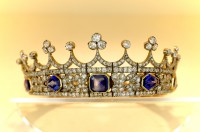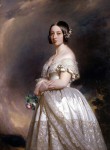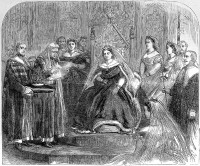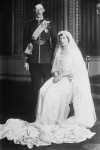 You might think a sapphire and diamond coronet designed by Prince Albert for Queen Victoria the year they were married would never be in danger of being exported out of the UK, but it is. The Culture Ministry has placed a temporary export ban on Queen Victoria’s coronet in the hopes that a buyer in the UK, ideally an institution, can raise the £5 million ($6,554,000) plus £1 million ($1,310,725) VAT to match the purchase price.
You might think a sapphire and diamond coronet designed by Prince Albert for Queen Victoria the year they were married would never be in danger of being exported out of the UK, but it is. The Culture Ministry has placed a temporary export ban on Queen Victoria’s coronet in the hopes that a buyer in the UK, ideally an institution, can raise the £5 million ($6,554,000) plus £1 million ($1,310,725) VAT to match the purchase price.
In the happy days before her widowhood, Victoria loved brightly colored gems, and Albert designed the coronet to match a sapphire and diamond brooch he had given to Victoria as a wedding present. Victoria was delighted with these gifts, writing in her journal “My dear Albert has such good taste and arranges everything for me about my jewellery.” In the case of the coronet, Albert arranged for Joseph Kitching, Goldsmith & Jeweller To His Serene Highness the Prince of Saxe-Coburg, to make it using gemstones that Victoria had gotten as gifts from her uncle King William IV and his wife Queen Adelaide. The small crown — just 4.5 inches wide — has 11 kite- and cushion-cut sapphires mounted in gold surrounded by diamonds mounted in silver. It cost £415.
 Victoria wore the coronet two years later in 1842 when she sat for one of the most famous portraits of the young queen by Franz Xaver Winterhalter. The fashionable artist’s first portrait of Queen Victoria captured her in white silk satin and lace gown reminiscent of her groundbreaking wedding dress which would launch the white wedding trend. The sapphire and diamond brooch Albert had given her the day before their wedding is pinned to her bosom, just as it was on her wedding dress. The coronet encircles the tidy bun on the back of her head. The painting became an iconic representation of Queen Victoria all over the world.
Victoria wore the coronet two years later in 1842 when she sat for one of the most famous portraits of the young queen by Franz Xaver Winterhalter. The fashionable artist’s first portrait of Queen Victoria captured her in white silk satin and lace gown reminiscent of her groundbreaking wedding dress which would launch the white wedding trend. The sapphire and diamond brooch Albert had given her the day before their wedding is pinned to her bosom, just as it was on her wedding dress. The coronet encircles the tidy bun on the back of her head. The painting became an iconic representation of Queen Victoria all over the world.
 Prince Albert’s death in 1861 sent Victoria into a period of inconsolable mourning that lasted for years. She wore black and made no public appearances, executing the duties of the monarch in seclusion at her favorite royal residences, avoiding Buckingham Palace and London as much as possible. Breaking two centuries of uninterrupted tradition, she refused to attend the State Opening of Parliament for five years, finally returning to the duty in 1866 under duress. The new Prime Minister Edward Smith-Stanley, 14th Earl of Derby, and future Prime Minister Benjamin Disraeli pressured the queen to attend the ceremony to quell politicians’ and the public’s increasing discontent with her withdrawal from public life. She did it with great reluctance, grumbling that it would be a terrible “shock to her nerves.” Instead of wearing the coronation crown, whose weight had caused her some pain during her coronation, she wore the little coronet, a reminder of her beloved husband.
Prince Albert’s death in 1861 sent Victoria into a period of inconsolable mourning that lasted for years. She wore black and made no public appearances, executing the duties of the monarch in seclusion at her favorite royal residences, avoiding Buckingham Palace and London as much as possible. Breaking two centuries of uninterrupted tradition, she refused to attend the State Opening of Parliament for five years, finally returning to the duty in 1866 under duress. The new Prime Minister Edward Smith-Stanley, 14th Earl of Derby, and future Prime Minister Benjamin Disraeli pressured the queen to attend the ceremony to quell politicians’ and the public’s increasing discontent with her withdrawal from public life. She did it with great reluctance, grumbling that it would be a terrible “shock to her nerves.” Instead of wearing the coronation crown, whose weight had caused her some pain during her coronation, she wore the little coronet, a reminder of her beloved husband.
 Neither Queen Alexandra nor Queen Mary wore the sapphire coronet. In 1922 King George V and Queen Mary gifted it to Princess Mary, their only daughter, as a wedding present when she married Viscount Lascelles, the future 6th Earl of Harewood, in 1922. Mary, Princess Royal after 1932 and Countess of Harewood after 1929, wore the coronet often on public occasions. After her death in 1965, the coronet fell out of view. It emerged in 1997 for an exhibition at the renown Wartski jewelers in London, on loan from the Countess of Harewood. In 2002 it was exhibited at the Victoria & Albert Museum’s Tiaras exhibition.
Neither Queen Alexandra nor Queen Mary wore the sapphire coronet. In 1922 King George V and Queen Mary gifted it to Princess Mary, their only daughter, as a wedding present when she married Viscount Lascelles, the future 6th Earl of Harewood, in 1922. Mary, Princess Royal after 1932 and Countess of Harewood after 1929, wore the coronet often on public occasions. After her death in 1965, the coronet fell out of view. It emerged in 1997 for an exhibition at the renown Wartski jewelers in London, on loan from the Countess of Harewood. In 2002 it was exhibited at the Victoria & Albert Museum’s Tiaras exhibition.
At some point after that it was sold to a dealer in London. The overseas owner requesting the export license bought it from that dealer. Whenever an export license is requested, the Reviewing Committee on the Export of Works of Art and Objects of Cultural Interest (RCEWA) studies the piece and determines whether its historical and cultural value is too significant to let it leave the country without a fight.
RCEWA member Philippa Glanville said:
“Key to the self-image of the young Victoria, this exquisite coronet was designed by her husband Prince Albert. Worn in her popular state portrait by Winterhalter of 1842, the year it was made, its combination of personal meaning and formality explains why she chose to wear it in 1866, emerging from mourning for the State Opening of Parliament. It evokes vividly the shared romantic taste of the time, and its form has become familiar through many reproductions. Its departure would be a great loss, given its beauty, its associations and its history.”
 Individuals and institutions have until December 27th, 2016, to raise the money or at least raise enough money to indicate they have a chance of matching the price if given a little more time. In that case, the temporary ban may be extended to June 27th, 2017.
Individuals and institutions have until December 27th, 2016, to raise the money or at least raise enough money to indicate they have a chance of matching the price if given a little more time. In that case, the temporary ban may be extended to June 27th, 2017.
If I were Queen Elizabeth II, I would be whipping out my checkbook right now. Which raises the question: are the Queen’s checkbooks plain or the kind with designs? I’m thinking horses in a field or Corgis at frolic.
I think the portrait by Franz Xaver Winterhalter was perfectly in tune with its time, both stylistically for the Victorian art world and personally (for a young queen). But how times change – you note that neither Queen Alexandra nor Queen Mary wore the sapphire coronet.
I hope the Culture Ministry places a permanent export ban on Queen Victoria’s coronet, so that it stays in a royal collection for ever. But don’t make future generations of royals wear 19th century jewels.
The Edwardian fashion was for heavier, layered pieces. Little chignon coronets were too subtle for the time. Still, everything is cyclical. It was worn by one of the daughters-in-law of the Countess of Harewood at her wedding in 1992.
I’m afraid there is no mechanism for permanent export bans. If nobody comes up with the money, the coronet is gone. These cases illustrate how many loopholes there are in the treasure trove laws.
I like the suggestion that Her Majesty might care to buy it. There would then, however, be an outcry about many other things for which she has not chosen to sign a cheque.
Better, I think, that some social-climbing rich man buy it and offer it as a gift to one of the museums. Do the like a few times, and he can hope for a knighthood for “charitable activities”.
I think she might manage to avoid backlash because it is truly a family piece. Her great-great-grandfather had it made for her great-great-grandmother who wore it one at least one momentous state occasion. It holds great sentimental appeal.
Finding a rich shill is a good plan. Arrivistes and their wads of cash have been of great use to the British aristocracy in the past, as attest to by many a Gilded Age American heiress.
I was not aware that Victoria even played a musical instrument…..(ahem)
Yuk yuk. 😉
The Queen’s personal bank account is with Coutts, basically an invite only private bank that has been around since the early 1700’s. I knew one of the family scions back in the day, believe it or not her name was….Penny Money Coutts.
So definitely horses in fields then. :giggle:
Penny Money Coutts is kind of great. Clearly her parents had a sense of humor.
“…which would launch the white wedding trend”? White wedding dresses were not worn previously?
And as much as an Anglophile that I am and as much as we all appreciate your high-def photos, perhaps the dear queen would be better served without one… poor thing…
They were not. The general practice was to wear the best dress in your wardrobe, no matter what the color. For the aristocracy wedding gowns were heavily brocaded with gold and silver thread. Victoria’s choice of a white dress — the kind worn by debutantes being presented at court for the first time — was so unusual at the time that it took decades for the trend she launched to become the settled tradition it is today.
You wore your best dress, which might be white but also any other color. Probably the year’s most fashionable color would be a desirable choice. But Victoria wore white, and white lace (which was re-used on other dresses for the rest of her life), and white became fashionable for bride’s dresses if one could afford a special dress for the occasion.
I suspect that one of the reasons Victoria may have chosen white was to stand out against the background so she could be seen, which is always a consideration when a queen chooses clothes (“never wear green to a tree planting”).
They want it to stay in the country so badly yet they’re willing to charge a $1 million Vat tax to the buyer for the privilege of keeping it. Seems kind of wacky to me
The VAT was charged and paid for by the business at the time of sale. If the matching price excluded that, then the dealer would be out a cool million.
A little Brexit never hurt anyone.
Thank you! Awesome blog!
Dear man…the queen does not have a checkbook. She has a chequebook.
Does William have that kind of money? It matches Kate’s ring. 😉
Workmanship and expensive stones aside, a pretty pedestrian piece. She has many flashier and more inventive, so why would she be interested? The store rooms at Windsor & Buck House must surely still be bursting with Albert memorabilia.
The Coronet should be returned to the Royal Collection. I could see it one day being worn by HRH Princess Charlotte of Cambridge.
I thought she called them ‘bank notes’.